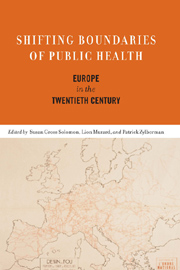Book contents
- Frontmatter
- Contents
- Preface
- Introduction
- Part One Place as Politics
- Part Two Carving Out the International
- 3 American Foundations and the Internationalizing of Public Health
- 4 Maneuvering for Space: International Health Work of the League of Nations during World War II
- 5 Europe, America, and the Space of International Health
- Part Three Preserving the Local
- Part Four Navigating between International and Local
- Selected Bibliography
- List of Contributors
- Index
4 - Maneuvering for Space: International Health Work of the League of Nations during World War II
from Part Two - Carving Out the International
Published online by Cambridge University Press: 12 September 2012
- Frontmatter
- Contents
- Preface
- Introduction
- Part One Place as Politics
- Part Two Carving Out the International
- 3 American Foundations and the Internationalizing of Public Health
- 4 Maneuvering for Space: International Health Work of the League of Nations during World War II
- 5 Europe, America, and the Space of International Health
- Part Three Preserving the Local
- Part Four Navigating between International and Local
- Selected Bibliography
- List of Contributors
- Index
Summary
The “space” within which an organization acts is shaped by its mandate, its financial and material resources, and its prestige, as well as the qualification, imagination and dedication of its staff. An organization's “space” may become contentious because of conflicting interpretations of the organization's function or because of alterations in the landscape in which that organization is embedded. For the League of Nations Health Organization (LNHO), which had been instrumental in establishing international public health during the interwar period, all of the above factors operated simultaneously during World War II. This chapter explores how the LNHO coped with and navigated the challenges of reduced and altered space.
The LNHO was particularly vulnerable for several reasons. To begin with, its functions were only vaguely defined. An early resolution listed the tasks of the LNHO as advising the League of Nations and voluntary organizations in matters affecting health, organizing a rapid interchange of information on epidemics and health missions, cooperating with the International Labour Organization (ILO) and the League of Red Cross Societies (LRCS) and providing a framework for international agreements. However, these points were put forth at the very early and provisional stages of the LNHO. They were not restated for the formation of the Permanent Health Organization in 1923, nor were new objectives ever negotiated. Indeed, the practice during eighteen years of LNHO policy clearly went beyond these narrow early limits.
- Type
- Chapter
- Information
- Shifting Boundaries of Public HealthEurope in the Twentieth Century, pp. 87 - 113Publisher: Boydell & BrewerPrint publication year: 2008



